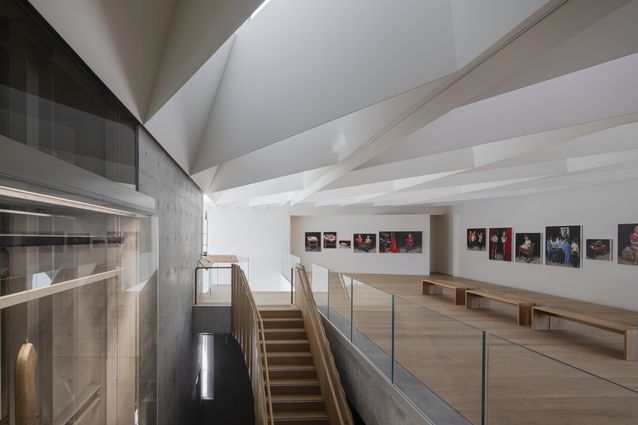For much of that year, it seemed obvious which project would attract the most attention in the non-residential areas of the Australian Institute of Architects 2020 National Awards, which were announced in a virtual ceremony Thursday night. And the extraordinary, the extraordinary, the paradigm-shattering gallery and theater that is fast becoming world famous like Sydney’s new Phoenix Central Park did just that when it won two of the major awards for two of Australia’s most prestigious design studios. John Wardle Architects created the gallery’s light brickwork, which looks almost like fabric, and duly won the Harry Seidler Award for commercial architecture. By lining the interiors with beautiful curves and wooden curves that are as fascinating as tide lines, according to the jury, Durbach Block Jaggers created “outstanding, very experimental, circular performance rooms” that were rightly awarded the Emil Sodersten Award interiors.
[dm-listing-recommendation experimentname=’midcontent-listings’ positiononpage=’midcontent’]
The Rhapsody by Durbach Block Jaggers in wood and sheet metal makes the performance rooms in Phoenix Central Park like an instrument. Photo: Martin Mischkulnig But the most rhapsodic award came from philanthropist and super-patron Judith Neilsen who, starting at her own home, Indigo Slam, then the White Rabbit Gallery, and now at Phoenix, over the past decade has placed three absolutely amazing buildings in the once cheeky neighborhoods in downtown Chippendale. Dr. Neilsen said Phoenix Central Park is the realization of an “open invitation to create something so close to the perfect ideal of architecture itself – the beauty of space and the poetry of light; the joy of use and the magic of the materials ”. BVN’s new Marrickville Library received two awards. Photo: Tom Roe It speaks for the outstanding quality of the 25 excellent national awards that were cut out of the 806 projects that were originally submitted for their national awards in this unrelated year, that common winners – or one of two projects won in different categories or a studio that won all awards in one category – became a common theme that evening. For example, the Top Name Award in the Houses New category went to Peter Stutchbury from Sydney for his permanent camp-like Basin Bay House in Mona Vale and for a completely different residence with a modernist flair – East St House in Albury – Kerstin Thompson Architects Melbourne, which also got its name at the Robin Boyd Award 2020. In Sydney, the new underground extension of the Anzac Memorial shared the main prize for public architecture. Photo: Brett Boardman The main Heritage Award was shared by two Tasmanian residential restorations; Hollow Tree House by Core Collective and Bozen’s Cottage by Taylor + Hinds. Another special feature because it has won two awards – for sustainability and the Sir Zelman Cowen Award for public architecture – is BVN’s wonderfully photogenic new Marrickville Library, which is not only credited with breathing so much new life into the community’s infrastructure has that the number of members has doubled. but rather to be conceived as such a breathable, light and energy-saving building. A memorial bridge recommended in the Urban category was the new Bridge of Remembrance in Hobart. Photo: John Gollings The other recipient of the Sir Zelman Cowen Award for Public Architecture was the subterranean extension of the Anzac Memorial in Sydney by Johnson Pilton Walker with NSW Government Architect. This room of reverential remembrance ushered in another common theme of the night, this time the celebration of buildings and structures erected as memorials, most of them to our past and present armed forces. One of the eight new stations in Sydney’s Metro North West won the major Urban Design Award. Photo: Martin Sykes In this category and in the Small Projects category, the Melbourne Praxis Edition Office won two awards in collaboration with two indigenous artists. The first, the Nicholas Murcutt Award, was for a permanent and somberly powerful structure erected at the Australian War Memorial in Canberra. Called For Our Country, and with contributions from artist Daniel Boyd, the incredibly beautiful construction is reminiscent of Aboriginal and Torres Strait Islanders who served the nation in conflict areas. The jury praised it as “a careful interplay of light and shadow, feel and symbolism”. The memorial to indigenous service personnel at the Australian War Memorial. Photo: Ben Hosking Edition Office’s second national Small Projects Award was given to the glass artist Yhonnie Scarce as a tall, hollow, dark tower that was supposed to highlight the idea of Terra Nullius. It was commissioned as a temporary piece of architecture for the National Gallery of Victoria. Another memorial structure about the war won a national commendation rather than the capital city building award. Noteworthy, however, is the Bridge of Remembrance by Denton Corker Marshall, which today connects two of Hobart’s most important memorials with a 200-meter-long “elegant, twisted airplane”. The prestigious Walter Burley Griffin Award for Urban Design was won by the eight-station project, known as Sydney Metro North West, which enlivens a 36-kilometer traffic corridor with diverse infrastructure and inviting public spaces. The design and engineering team, led by Hassell in collaboration with Turpin Crawford Studio and McGregor Westlake Architecture, had so many names that demanded recognition that it was almost “role credits.” But that’s what it takes to get a big new infrastructure project off the ground; a huge cast of creative mind and muscle power.
[dm-listing-recommendation experimentname=’below-content-listings’ positiononpage=’belowContent’]
[ad_2]












